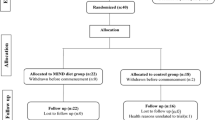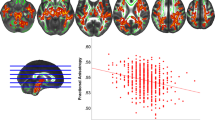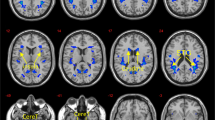Abstract
Background/Objectives:
Growing evidence implicates neuroinflammation in the pathogenesis of diet-induced obesity and cognitive dysfunction in rodent models. Obesity is associated with reduced white matter integrity and cognitive decline. Circulating lipopolysaccharide binding protein (LBP) concentration is known to be increased in patients with obesity. Here, we aimed to evaluate whether circulating LBP is associated longitudinally with white matter structure and cognitive performance according to obesity status.
Subjects/Methods:
This longitudinal study analyzed circulating LBP (ELISA), DTI-metrics (axial diffusivity (L1), fractional anisotropy (FA) and radial diffusivity (RD)) in specific regions of the white matter of 24 consecutive middle-aged obese subjects (13 women) and 20 healthy volunteers (10 women) at baseline and two years later. Digit Span Test (DST) was used as a measure of working memory/short-term verbal memory.
Results:
Circulating LBP concentration was associated with FA and L1 values of several white matter regions both at baseline and follow-up. The associations remained significant after controlling for age, BMI, fat mass and plasma high sensitivity C-reactive protein. Importantly, the increase in LBP over time impacted negatively on FA and L1 values and on DST performance.
Conclusions:
Circulating LBP associates with brain white matter integrity and working memory/short-term verbal memory in both obese and non-obese subjects.
This is a preview of subscription content, access via your institution
Access options
Subscribe to this journal
Receive 12 print issues and online access
$259.00 per year
only $21.58 per issue
Buy this article
- Purchase on Springer Link
- Instant access to full article PDF
Prices may be subject to local taxes which are calculated during checkout


Similar content being viewed by others
References
Kullmann S, Schweizer F, Veit R, Fritsche A, Preissl H . Compromised white matter integrity in obesity. Obes Rev 2015; 16: 273–281.
He Q, Chen C, Dong Q, Xue G, Chen C, Lu ZL et al. Gray and white matter structures in the midcingulate cortex region contribute to body mass index in Chinese young adults. Brain Struct Funct 2015; 220: 319–329.
Bolzenius JD, Laidlaw DH, Cabeen RP, Conturo TE, McMichael AR, Lane EM et al. Brain structure and cognitive correlates of body mass index in healthy older adults. Behav Brain Res 2015; 278: 342–347.
Ryan L, Walther K . White matter integrity in older females is altered by increased body fat. Obesity (Silver Spring) 2014; 22: 2039–2046.
Karlsson HK, Tuulari JJ, Hirvonen J, Lepomäki V, Parkkola R, Hiltunen J et al. Obesity is associated with white matter atrophy: a combined diffusion tensor imaging and voxel-based morphometric study. Obesity (Silver Spring) 2013; 21: 2530–2537.
Verstynen TD, Weinstein AM, Schneider WW, Jakicic JM, Rofey DL, Erickson KI . Increased body mass index is associated with a global and distributed decrease in white matter microstructural integrity. Psychosom Med 2012; 74: 682–690.
Xu J, Li Y, Lin H, Sinha R, Potenza MN . Body mass index correlates negatively with white matter integrity in the fornix and corpus callosum: a diffusion tensor imaging study. Hum Brain Mapp 2013; 34: 1044–1052.
Stanek KM, Grieve SM, Brickman AM, Korgaonkar MS, Paul RH, Cohen RA et al. Obesity is associated with reduced white matter integrity in otherwise healthy adults. Obesity (Silver Spring) 2011; 19: 500–504.
Zhang Y, Ji G, Xu M, Cai W, Zhu Q, Qian L et al. Recovery of brain structural abnormalities in morbidly obese patients after bariatric surgery. Int J Obes (Lond) 2016; 40: 1558–1565.
Tuulari JJ, Karlsson HK, Antikainen O, Hirvonen J, Pham T, Salminen P et al. Bariatric surgery induces white and grey matter density recovery in the morbidly obese: a voxel-based morphometric study. Hum Brain Mapp 2016; 37: 3745–3756.
De Souza CT, Araujo EP, Bordin S, Ashimine R, Zollner RL, Boschero AC et al. Consumption of a fat-rich diet activates a proinflammatory response and induces insulin resistance in the hypothalamus. Endocrinology 2005; 146: 4192–41999.
Thaler JP, Schwartz MW . Minireview: Inflammation and obesity pathogenesis: the hypothalamus heats up. Endocrinology 2010; 151: 4109–4115.
Posey KA, Clegg DJ, Printz RL, Byun J, Morton GJ, Vivekanandan-Giri A et al. Hypothalamic proinflammatory lipid accumulation, inflammation, and insulin resistance in rats fed a high-fat diet. Am J Physiol Endocrinol Metab 2009; 296: E1003–E1012.
Thaler JP, Yi CX, Schur EA, Guyenet SJ, Hwang BH, Dietrich MO et al. Obesity is associated with hypothalamic injury in rodents and humans. J Clin Invest 2012; 122: 153–162.
Hailman E, Lichenstein HS, Wurfel MM, Miller DS, Johnson DA, Kelley M et al. Lipopolysaccharide (LPS)-binding protein accelerates the binding of LPS to CD14. J Exp Med 1994; 179: 269–277.
Sun L, Yu Z, Ye X, Zou S, Li H, Yu D et al. A marker of endotoxemia is associated with obesity and related metabolic disorders in apparently healthy Chinese. Diabetes Care 2010; 33: 1925–1932.
Moreno-Navarrete JM, Ortega F, Serino M, Luche E, Waget A, Pardo G et al. Circulating lipopolysaccharide-binding protein (LBP) as a marker of obesity-related insulin resistance. Int J Obes (Lond) 2012; 36: 1442–1449.
Serrano M, Moreno-Navarrete JM, Puig J, Moreno M, Guerra E, Ortega F et al. Serum lipopolysaccharide-binding protein as a marker of atherosclerosis. Atherosclerosis 2013; 230: 223–227.
Tilves CM, Zmuda JM, Kuipers AL, Nestlerode CS, Evans RW, Bunker CH et al. Association of lipopolysaccharide-binding protein with aging-related adiposity change and prediabetes among african ancestry men. Diabetes Care 2016; 39: 385–391.
Liu X, Lu L, Yao P, Ma Y, Wang F, Jin Q et al. Lipopolysaccharide binding protein, obesity status and incidence of metabolic syndrome: a prospective study among middle-aged and older Chinese. Diabetologia 2014; 57: 1834–1841.
Escribano BM, Medina-Fernández FJ, Aguilar-Luque M, Agüera E, Feijoo M, Garcia-Maceira FI et al. Lipopolysaccharide binding protein and oxidative stress in a multiple sclerosis model. Neurotherapeutics 2017; 14: 199–211.
Medina-Fernández FJ, Luque E, Aguilar-Luque M, Agüera E, Feijóo M, García-Maceira FI et al. Transcranial magnetic stimulation modifies astrocytosis, cell density and lipopolysaccharide levels in experimental autoimmune encephalomyelitis. Life Sci 2017; 169: 20–26.
Lee WY, Park JS, Noh SY, Rhee EJ, Sung KC, Kim BS et al. C-reactive protein concentrations are related to insulin resistance and metabolic syndrome as defined by the ATP III report. Int J Cardiol 2004; 97: 101–106.
Florez H, Castillo-Florez S, Mendez A, Casanova-Romero P, Larreal-Urdaneta C, Lee D et al. C-reactive protein is elevated in obese patients with the metabolic syndrome. Diabetes Res Clin Pract 2006; 71: 92–100.
Pecht T, Gutman-Tirosh A, Bashan N, Rudich A . Peripheral blood leucocyte subclasses as potential biomarkers of adipose tissue inflammation and obesity subphenotypes in humans. Obes Rev 2014; 15: 322–337.
Lee D, Thaler JP, Berkseth KE, Melhorn SJ, Schwartz MW, Schur EA . Longer T(2) relaxation time is a marker of hypothalamic gliosis in mice with diet-induced obesity. Am J Physiol Endocrinol Metab 2013; 304: E1245–E1250.
Alkan A, Sahin I, Keskin L, Cikim AS, Karakas HM, Sigirci A et al. Diffusion-weighted imaging features of brain in obesity. Magn Reson Imaging 2008; 26: 446–450.
Puig J, Blasco G, Daunis-I-Estadella J, Molina X, Xifra G, Ricart W et al. Hypothalamic damage is associated withinflammatory markers and worse cognitive performance in obese subjects. J Clin Endocrinol Metab 2015; 100: E276–E281.
Miralbell J, Soriano JJ, Spulber G, López-Cancio E, Arenillas JF, Bargalló N et al. Structural brain changes and cognition in relation to markers of vascular dysfunction. Neurobiol Aging 2012; 33: 1003.e9–17.
Wersching H, Duning T, Lohmann H, Mohammadi S, Stehling C, Fobker M et al. Serum C-reactive protein is linked to cerebral microstructural integrity and cognitive function. Neurology 2010; 74: 1022–1029.
Smith SM, Jenkinson M, Johansen-Berg H, Rueckert D, Nichols TE, Mackay CE et al. Tract-based spatial statistics: voxelwise analysis of multi-subject diffusion data. Neuroimage 2006; 31: 1487–1505.
Smith SM, Jenkinson M, Woolrich MW, Beckmann CF, Behrens TE, Johansen-Berg H et al. Advances in functional and structural MR image analysis and implementation as FSL. Neuroimage 2004; 23: S208–S219.
Eickhoff SB, Stephan KE, Mohlberg H, Grefkes C, Fink GR, Amunts K et al. A new SPM toolbox for combining probabilistic cytoarchitectonic maps and functional imaging data. Neuroimage 2005; 25: 1325–1335.
Mori S, Wakana S, Nagae-Poetscher LM, van Zijl PCM . MRI Atlas of Human White Matter. Elsevier: Amsterdam, The Netherlands, 2005.
Winkler AM, Ridgway GR, Webster MA, Smith SM, Nichols TE . Permutation inference for the general linear model. Neuroimage 2014; 92: 381–397.
Wechsler D . WAIS-III. Escala de inteligencia de Wechsler para adultos-III. Madrid: TEA, 1999.
Marques EL, Halpern A, Corrêa Mancini M, de Melo ME, Horie NC, Buchpiguel CA et al. Changes in neuropsychological tests and brain metabolism after bariatric surgery. J Clin Endocrinol Metab 2014; 99: E2347–E2352.
Fergenbaum JH, Bruce S, Lou W, Hanley AJ, Greenwood C, Young TK . Obesity and lowered cognitive performance in a Canadian First Nations population. Obesity (Silver Spring) 2009; 17: 1957–1963.
Debette S, Seshadri S, Beiser A, Au R, Himali JJ, Palumbo C et al. Mid life vascular risk factor exposure accelerates structural brain aging and cognitive decline. Neurology 2011; 77: 461–468.
Singh-Manoux A, Czernichow S, Elbaz A, Dugravot A, Sabia S, Hagger-Johnson G et al. Obesity phenotypes in midlife and cognition in earlyoldage: the Whitehall II cohort study. Neurology 2012; 79: 755–762.
Bressler J, Fornage M, Demerath EW, Knopman DS, Monda KL, North KE et al. Fat mass and obesity gene and cognitive decline: the Atherosclerosis Risk in Communities Study. Neurology 2013; 80: 92–99.
Cazettes F, Cohen JI, Yau PL, Talbot H, Convit A . Obesity-mediated inflammation may damage the brain circuit that regulates food intake. Brain Res 2011; 1373: 101–109.
Verstynen TD, Weinstein A, Erickson KI, Sheu LK, Marsland AL, Gianaros PJ . Competing physiological pathways link individual differences in weight and abdominal adiposity to white matter microstructure. Neuroimage 2013; 79: 129–137.
Gu Y, Vorburger R, Scarmeas N, Luchsinger JA, Manly JJ, Schupf N et al. Circulating inflammatory biomarkers in relation to brain structural measurements in a non-demented elderly population. Brain Behav Immun 2017. epub ahead of print 27 April 2017 doi:10.1016/j.bbi.2017.04.022.
Yang PJ, Lee WJ, Tseng PH, Lee PH, Lin MT, Yang WS . Bariatric surgery decreased the serum level of an endotoxin-associated marker: lipopolysaccharide-binding protein. Surg Obes Relat Dis 2014; 10: 1182–1187.
Daugherty AM, Raz N . Accumulation of iron in the putamen predicts its shrinkage in healthy older adults: A multi-occasion longitudinal study. Neuroimage 2016; 128: 11–20.
Rubin DB . Causal inference using potential outcomes: design, modeling, decisions. J Am Stat Assoc 2005; 100: 322–331.
Winship C, Morgan SL . The estimation of causal effects from observational data. Ann Rev Sociol 1999; 25: 659–706.
Pearl J . Interpretation and identification of causal mediation. Psychol Methods 2014; 19: 459–481.
Wei L, Simen A, Mane S, Kaffman A . Early life stress inhibits expression of a novel innate immune pathway in the developing hippocampus. Neuropsychopharmacology 2012; 37: 567–580.
Stevens B, Allen NJ, Vazquez LE, Howell GR, Christopherson KS, Nouri N et al. The classical complement cascade mediates CNS synapse elimination. Cell 2007; 131: 1164–1178.
Cani PD, Bibiloni R, Knauf C, Waget A, Neyrinck AM, Delzenne NM et al. Changes in gut microbiota control metabolic endotoxemia-induced inflammation in high-fat diet-induced obesity and diabetes in mice. Diabetes 2008; 57: 1470–1481.
Wang S, Huang XF, Zhang P, Wang H, Zhang Q, Yu S et al. Chronic rhein treatment improves recognition memory in high-fat diet-induced obese male mice. J Nutr Biochem 2016; 36: 42–50.
Sobesky JL, D'Angelo HM, Weber MD, Anderson ND, Frank MG, Watkins LR et al. Glucocorticoids Mediate Short-Term High-Fat Diet Induction of Neuroinflammatory Priming, the NLRP3 Inflammasome, and the Danger Signal HMGB1. eNeuro 2016; 3: 4.
Guillemot-Legris O, Muccioli GG . Obesity-Induced Neuroinflammation: Beyond the Hypothalamus. Trends Neurosci 2017; 40: 237–253.
Balusu S, Van Wonterghem E, De Rycke R, Raemdonck K, Stremersch S, Gevaert K et al. Identification of a novel mechanism of blood-brain communication during peripheral inflammation via choroid plexus-derived extracellular vesicles. EMBO Mol Med 2016; 8: 1162–1183.
Moreno-Navarrete JM, Escoté X, Ortega F, Camps M, Ricart W, Zorzano A et al. Lipopolysaccharide binding protein is an adipokine involved in the resilience of the mouse adipocyte to inflammation. Diabetologia 2015; 58: 2424–2434.
Pang J, Xu W, Zhang X, Wong GL, Chan AW, Chan HY et al. Significant positive association of endotoxemia with histological severity in 237 patients with non-alcoholic fatty liver disease. Aliment Pharmacol Ther 2017; 46: 175–182.
Laugerette F, Alligier M, Bastard JP, Drai J, Chanséaume E, Lambert-Porcheron S et al. Overfeeding increases postprandial endotoxemia in men: Inflammatory outcome may depend on LPS transporters LBP and sCD14. Mol Nutr Food Res 2014; 58: 1513–1518.
Gavaldà-Navarro A, Moreno-Navarrete JM, Quesada-López T, Cairó M, Giralt M, Fernández-Real JM et al. Lipopolysaccharide-binding protein is a negative regulator of adipose tissue browning in mice and humans. Diabetologia 2016; 59: 2208–2218.
Menon V . Memory and cognitive control circuits in mathematical cognition and learning. Prog Brain Res 2016; 227: 159–186.
Acknowledgements
This work was partially supported by research grant PI15/01934 and PI16/02173 from the Instituto de Salud Carlos III from Spain and was also supported by FEDER funds. CIBEROBN Fisiopatología de la Obesidad y Nutrición is an initiative from the Instituto de Salud Carlos III from Spain. We acknowledge the technical assistance of M. Sabater, E. Loshuertos and O. Rovira (both from Endocrinology, IdIBGi, Spain).
Author information
Authors and Affiliations
Corresponding authors
Ethics declarations
Competing interests
The authors declare no conflict of interest.
Additional information
Supplementary Information accompanies this paper on International Journal of Obesity website
Rights and permissions
About this article
Cite this article
Moreno-Navarrete, J., Blasco, G., Puig, J. et al. Neuroinflammation in obesity: circulating lipopolysaccharide-binding protein associates with brain structure and cognitive performance. Int J Obes 41, 1627–1635 (2017). https://doi.org/10.1038/ijo.2017.162
Received:
Revised:
Accepted:
Published:
Issue Date:
DOI: https://doi.org/10.1038/ijo.2017.162
This article is cited by
-
Vivaria housing conditions expose sex differences in brain oxidation, microglial activation, and immune system states in aged hAPOE4 mice
Experimental Brain Research (2024)
-
Brain functional and structural magnetic resonance imaging of obesity and weight loss interventions
Molecular Psychiatry (2023)
-
Mechanisms linking obesity and its metabolic comorbidities with cerebral grey and white matter changes
Reviews in Endocrine and Metabolic Disorders (2022)
-
Cognition, Brain Structure, and Brain Function in Individuals with Obesity and Related Disorders
Current Obesity Reports (2020)
-
Shift rotation, circadian misalignment and excessive body weight influence psychomotor performance: a prospective and observational study under real life conditions
Scientific Reports (2019)



